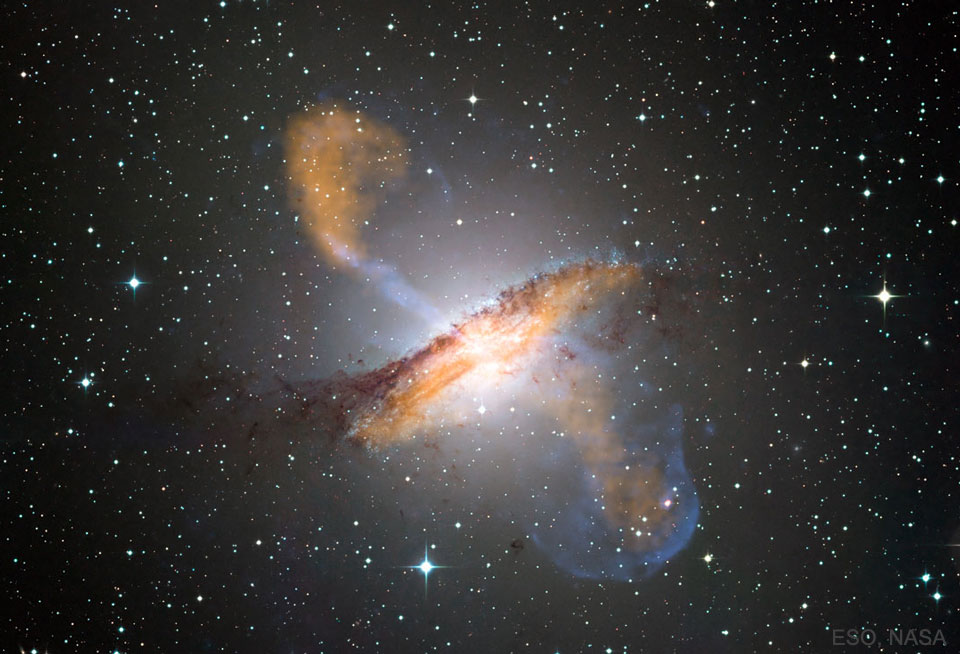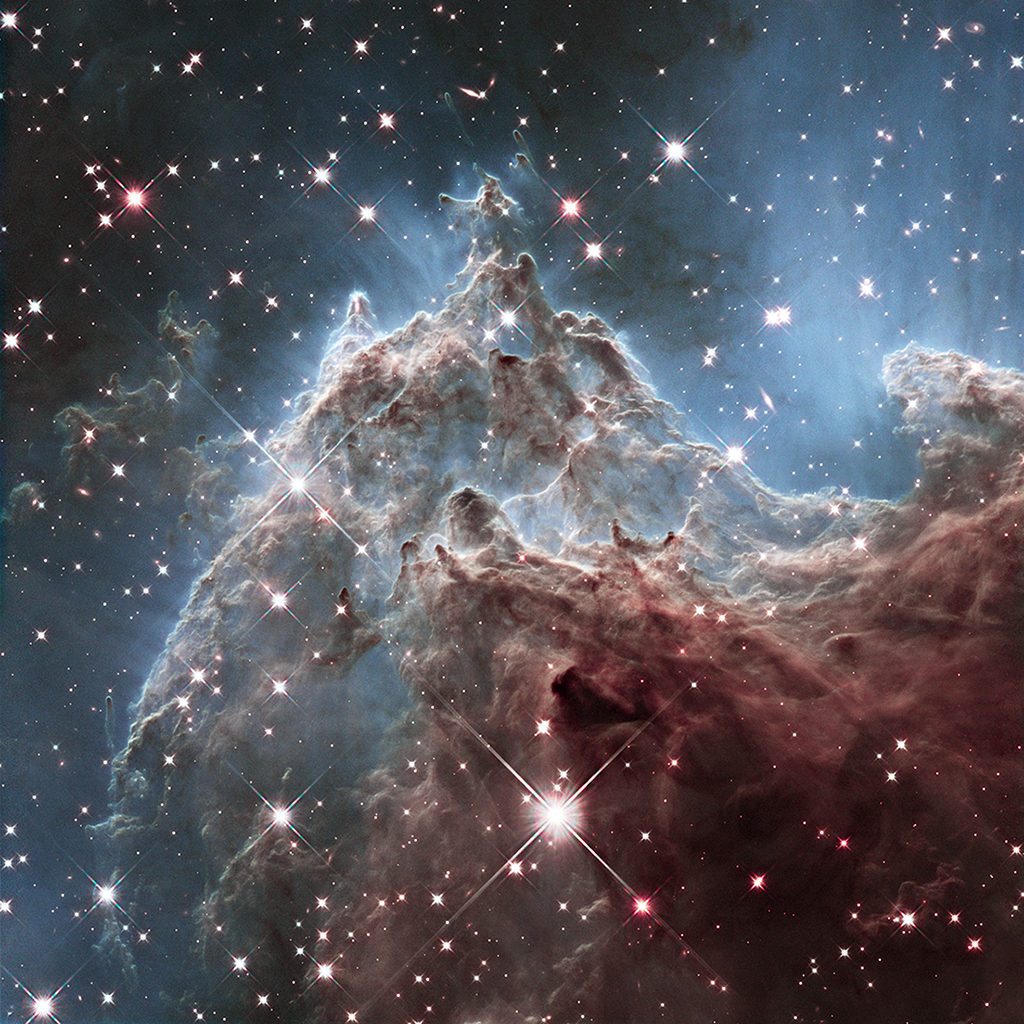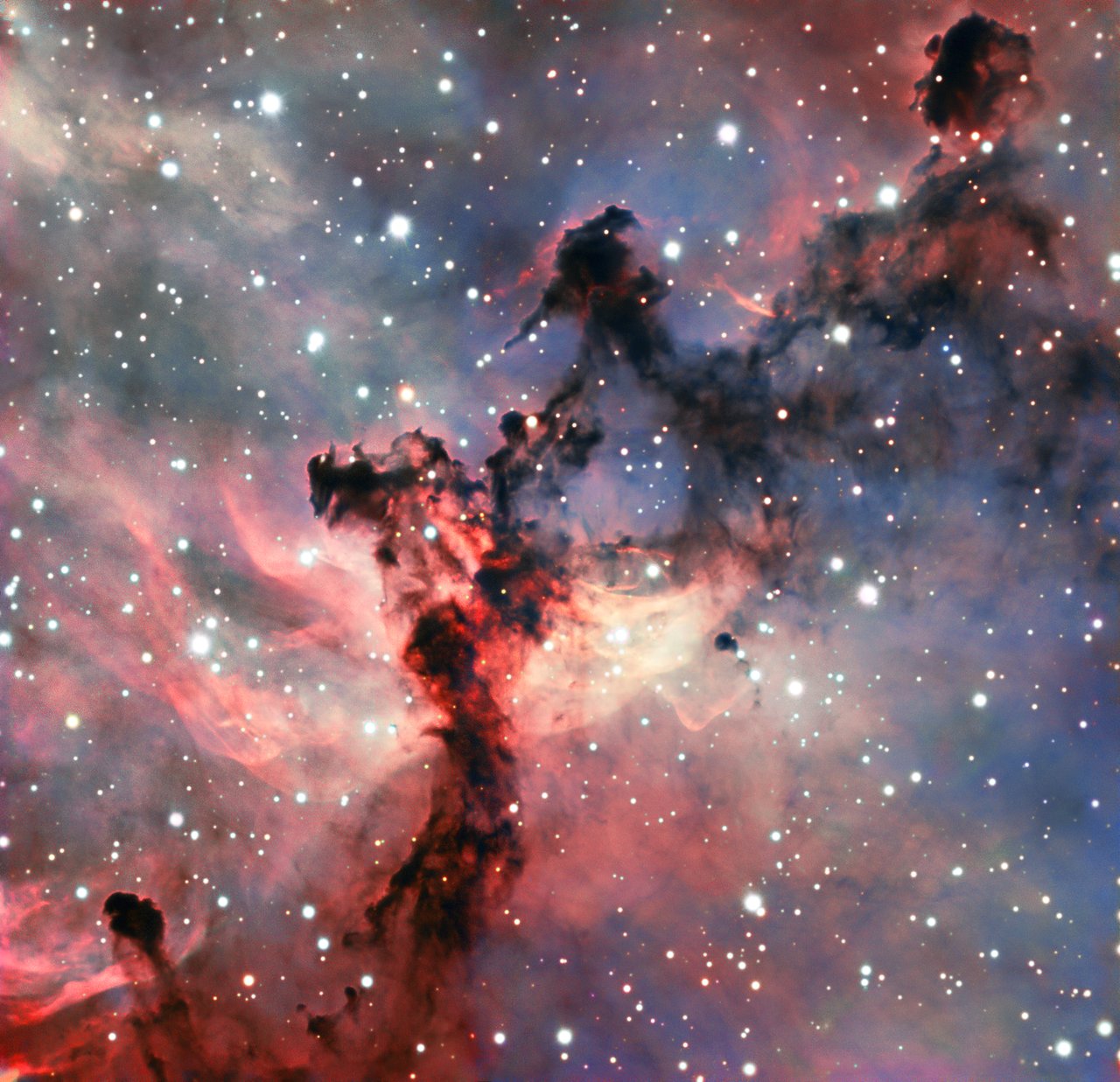Blog
The jets emanating from Centaurus A are over a million light years long. These jets of streaming plasma, expelled by a giant black hole in the center of this spiral galaxy, light up this composite image of Cen A. Exactly how the central black hole expels infalling matter remains unknown. After clearing the galaxy, however, the jets inflate large radio bubbles that likely glow for millions of years. If energized by a passing gas cloud, the radio bubbles can even light up again after billions of years. X-ray light is depicted in the featured composite image in blue, while microwave light is colored orange. The base of the jet in radio light showsdetails of the innermost light year of the central jet.

Cyrus Chestnut (born January 17, 1963) is an American jazz pianist, composer and producer. In 2006, Josh Tyrangiel, music critic for Time, wrote: “What makes Chestnut the best jazz pianist of his generation is a willingness to abandon notes and play space.”
Cyrus Chestnut was born in Baltimore, Maryland, in 1963, son of McDonald (a retired post-office employee and church pianist) and Flossie (a city social services worker and church choir director). Chestnut started learning piano at the age of seven, and in his boyhood played at Mount Calvary Baptist Church. By the age of nine, he was studying classical music at the Peabody Institute. In 1985, Chestnut earned a degree in jazz composition and arranging from Boston’s Berklee College of Music.
more...Billy Harper (born January 17, 1943) is an American jazz saxophonist, “one of a generation of Coltrane-influenced tenor saxophonists” with a distinctively stern, hard-as-nails sound on his instrument. In 1965 Harper earned a Bachelor of Music degree from the University of North Texas.
Harper has played with some of jazz’s greatest drummers; he served with Art Blakey‘s Messengers for two years (1968–70); he played very briefly with Elvin Jones (1970), he played with the Thad Jones/ Mel Lewis Orchestra in the 1970s, and was a member of Max Roach‘s quartet from 1971-1978. In 1979, Harper formed his own group, touring with it and documenting its music on the recording Billy Harper Quintet in Europe, and he was featured as a soloist on a 1983 recording, Such Great Friends, with virtuoso, visionary pianist and record producer Stanley Cowell. After a period of relative inactivity in the 1980s, Harper came back strong with another international tour, which ended with perhaps his most ambitious recording: the three-volume Live on Tour in the Far East (1991). In the new millennium Harper’s recording activity has been subdued and sporadic, though more recently he appeared as a regular member of pianist-jazz historian Randy Weston‘s ensembles. In 2013 they recorded their first album as a duo, entitled The Roots of the Blues.
more...Cedar Anthony Walton, Jr. (January 17, 1934 – August 19, 2013) was an American hard bop jazz pianist. He came to prominence as a member of drummer Art Blakey‘s band before establishing a long career as a bandleader and composer. Several of his compositions have become jazz standards, including “Mosaic”, “Bolivia”, “Holy Land”, “Mode for Joe” and “Fantasy in D”.
Walton was born and grew up in Dallas, Texas. His mother Ruth was an aspiring concert pianist, and was Walton’s initial teacher. She also took him to jazz performances around Dallas. Walton cited Nat King Cole, Bud Powell, Thelonious Monk and Art Tatum as his major influences on piano.He began emulating recordings of these artists from an early age.
After briefly attending Dillard University in New Orleans, he went to the University of Denver as a composition major originally, but was encouraged to switch to a music education program targeted to set up a career in the local public school system. This switch later proved extremely useful since Walton learned to play and arrange for various instruments, a talent he would hone with Art Blakey’s Jazz Messengers.
Walton was tempted by the promise of New York City through his associations with John Coltrane, Charlie Parker, and Richie Powell, whom he met at various after-hours sessions around the city of Denver, Colorado. In 1955, he decided to leave school and drove with a friend to New York City. He quickly got recognition from Johnny Garry, who ran Birdland at that time.
more...Sidney “Big Sid” Catlett (January 17, 1910 – March 25, 1951) was an American jazz drummer. Catlett was one of the most versatile drummers of his era, adapting with the changing music scene as it progressed toward bebop.
Catlett was born in Evansville, Indiana and at an early age he was instructed in the rudiments of piano and drums under the tutelage of a music teacher hired by his mother. When he and his family relocated to Chicago, Catlett received his first drum kit, and immersed himself in the diverse styles and techniques of Zutty Singleton, Warren “Baby” Dodds, and Jimmy Bertrand, among others. In 1928, Catlett began playing with violinist and clarinet player Darnell Howard, before joining pianist Sammy Stewart’s Orchestra in New York City and making appearances at the Savoy Ballroom.
After performing for several lesser established musical acts, Catlett began recording and performing with multiple musicians including Benny Carter, McKinney’s Cotton Pickers, Fletcher Henderson, and Don Redman throughout the 1930s. Between 1938 and 1942, Catlett was Louis Armstrong‘s drummer of choice as he was regularly featured in Armstrong’s big band, while also periodically joining Benny Goodman‘s group. Following a brief stint in collaboration with Duke Ellington in 1945, Catlett led some of his own bands through the remainder of the 1940s, and was involved in Armstrong’s All-Stars between 1947 and 1949.
more...NGC 2174 a star forming region about 6,400 light-years away in the nebula-rich constellation of Orion. It follows mountainous clouds of gas and dust carved by winds and radiation from the region’s newborn stars, now found scattered in open star clusters embedded around the center of NGC 2174, off the top of the frame. Though star formation continues within these dusty cosmic clouds they will likely be dispersed by the energetic newborn stars within a few million years. Recorded at infrared wavelengths by the Hubble Space Telescope in 2014, the interstellar scene spans about 6 light-years. Scheduled for launch in 2021, the James Webb Space Telescope is optimized for exploring the Universe at infrared wavelengths.

Aldo Romano (born 16 January 1941) is a jazz drummer. He also founded a rock group in 1971.
Romano moved to France as a child and by the 1950s he was playing guitar and drums professionally in Paris, but he first gained attention when he started working with Don Cherry in 1963. He recorded with Steve Lacy and would go on to tour with Dexter Gordon among others. In the 1970s, he moved into rock-influenced forms of jazz fusion and in 1978 made his first album as a leader. In the 1980s, he returned to his earlier style for several albums. Although he has lived most of his life in France, he has retained an affection for Italy and has set up a quartet of Italian jazz musicians. Romano also played a role in starting the career of French-born Italian-French pianist Michel Petrucciani. In 2004 he won the Jazzpar Prize.
more...Barbara Lynn (born Barbara Lynn Ozen, later Barbara Lynn Cumby, January 16, 1942) is an American rhythm and blues and electric bluesguitarist, singer and songwriter. She is best known for her R&B chart-topping hit, “You’ll Lose a Good Thing” (1962). In 2018, Lynn received the National Heritage Fellowship.
She was born in Beaumont, Texas, and attended Hebert High School. She played piano as a child, but switched to guitar, which she plays left-handed. Inspired by blues artists Guitar Slim and Jimmy Reed, and pop acts Elvis Presley and Brenda Lee, and winning several local talent shows, she created an all-female band, Bobbie Lynn and Her Idols.She began performing in local clubs in Texas. Singer Joe Barry saw her and introduced Lynn to producer Huey P. Meaux, who ran SugarHill Recording Studios and several record labels in New Orleans. Her first single, “You’ll Lose A Good Thing”, co-written by her and Meaux, was recorded at Cosimo Matassa‘s J&M studio with session musicians including Mac Rebennack (Dr. John). Released by Jamie Records, it was a number 1 USBillboard R&B chart hit and Top 10 Billboard Hot 100 hit in 1962. The song was later recorded by Aretha Franklin and became a country hit recordfor Freddy Fender. Reggae artist Mikey Dread also based the melody of his 1989 single “Choose Me” on this song. Lynn also released an album, also titled You’ll Lose A Good Thing, which featured ten of her compositions.
https://www.youtube.com/watch?v=nKq_9R_NGXM
more...This colourful image shows a part of the Rosette Nebula in the constellation of Monoceros (The Unicorn). It is an emission nebula, composed of clouds of gas that are made to glow by the radiation emanating from stars within. The Rosette Nebula is a fairly typical example of an emission nebula — but typical does not mean boring! Nebulae are some of the most beautiful celestial objects out there, and they frequently show up spectacularly in images taken by astronomical telescopes, as seen here. In nebulae such as this, gas and dust are combining to produce a new generation of stars. Initially these newly-formed stars are shrouded in the dusty clouds that gave them birth, and cannot be seen in visible light. But after a while they blow away the denser material and their powerful radiation pours out to ionise the surrounding gas, causing it to glow brightly. These elements are all present in this image — the mixture of glowing gas and dark dust has been sculpted into complex patterns on the sky by the stellar radiation, like smoke around a fire. This particular image was obtained with the FORS 2 instrument on ESO’s Very Large Telescope, sited in the harsh environment of Chile’s Atacama Desert. FORS 2 is an extremely versatile instrument that can produce very high-quality images (like this one!). It is also a spectrograph that can split the light it collects into a rainbow of colours, giving astronomers information about the chemical composition of objects across the Universe. This image was created as part of the ESO Cosmic Gems programme, an outreach initiative to produce images of interesting, intriguing or visually attractive objects using ESO telescopes, for the purposes of education and public outreach. The programme makes use of telescope time that cannot be used for science observations. All data collected may also be suitable for scientific purposes, and are made available to astronomers through ESO’s science archive.

Don Van Vliet (/væn ˈvliːt/, born Don Glen Vliet; January 15, 1941 – December 17, 2010) was an American singer, songwriter, multi-instrumentalist, and visual artist best known by the stage name Captain Beefheart. He conducted a rotating ensemble called the Magic Band, with whom he recorded 13 studio albums between 1964 and 1982. His music blended elements of blues, free jazz, rock, and avant-garde composition with idiosyncratic rhythms, absurdist wordplay, and his wide vocal range. Known for his enigmatic persona, Beefheart frequently constructed myths about his life and was known to exercise an almost dictatorial control over his supporting musicians. Although he achieved little commercial success, he sustained a cult following as a “highly significant” and “incalculable” influence on an array of new wave, punk, and experimental rock artists.
An artistic prodigy in his childhood, Van Vliet developed an eclectic musical taste during his teen years in Lancaster, California, and formed “a mutually useful but volatile” friendship with musician Frank Zappa, with whom he sporadically competed and collaborated. He began performing with his Captain Beefheart persona in 1964 and joined the original Magic Band line-up, initiated by Alexis Snouffer, the same year. The group released their debut album Safe as Milk in 1967 on Buddah Records. After being dropped by two consecutive record labels they signed to Zappa’s Straight Records, where they released 1969’s Trout Mask Replica; the album would later rank 58th in Rolling Stone magazine’s 2003 list of the 500 greatest albums of all time. In 1974, frustrated by lack of commercial success, he pursued a more conventional rock sound, but the ensuing albums were critically panned; this move, combined with not having been paid for a European tour, and years of enduring Beefheart’s abusive behavior, led the entire band to quit.
Beefheart eventually formed a new Magic Band with a group of younger musicians and regained critical approval through three final albums: Shiny Beast (1978), Doc at the Radar Station (1980) and Ice Cream for Crow (1982). Van Vliet made few public appearances after his retirement from music in 1982. He pursued a career in art, an interest that originated in his childhood talent for sculpture, and a venture which proved to be his most financially secure. His expressionist paintings and drawings command high prices, and have been exhibited in art galleries and museums across the world. Van Vliet died in 2010, having suffered from multiple sclerosis for many years.
more...Earl Zebedee Hooker (January 15, 1930 – April 21, 1970) was a Chicago blues guitarist known for his slide guitar playing. Considered a “musician’s musician”, he performed with blues artists such as Sonny Boy Williamson II, Junior Wells, and John Lee Hooker and fronted his own bands. An early player of the electric guitar, Hooker was influenced by the modern urban styles of T-Bone Walker and Robert Nighthawk. He recorded several singles and albums as a bandleader and with other well-known artists. His “Blue Guitar”, a slide guitar instrumental single, was popular in the Chicago area and was later overdubbed with vocals by Muddy Waters as “You Shook Me“.
In the late 1960s, Hooker began performing on the college and concert circuit and had several recording contracts. Just as his career was on an upswing, he died in 1970, at age 40, after a lifelong struggle with tuberculosis. His guitar playing has been acknowledged by many of his peers, including B.B. King, who commented, “to me he is the best of modern guitarists. Period. With the slide he was the best. It was nobody else like him, he was just one of a kind”. Hooker was born in rural Quitman County, Mississippi, outside of Clarksdale. In 1930, his parents moved the family to Chicago, during the Great Migration of blacks out of the rural South in the early 20th century.
His family was musically inclined (John Lee Hooker was a cousin), and Earl heard music played at home at an early age. About age ten, he started playing the guitar. He was self-taught and picked up what he could from those around him. He developed proficiency on the guitar but showed no interest in singing. He had pronounced stuttering, which afflicted him all his life. Hooker contracted tuberculosis when he was young. The disease did not become critical until the mid-1950s, but it required periodic hospitalizations, beginning at an early age.
more...Eugene Bertram Krupa (January 15, 1909 – October 16, 1973) was an American jazz drummer, band leader and composer known for his energetic style and showmanship. His drum solo on “Sing, Sing, Sing” (1937) elevated the role of the drummer from an accompanying line to an important solo voice in the band. In collaboration with the Slingerland drum and Zildjian cymbal manufacturers, he was a major force in defining the standard band drummer’s kit. Krupa is considered “the founding father of the modern drumset” by Modern Drummer magazine.
The youngest of Anna (née Oslowski) and Bartłomiej Krupa’s nine children, Gene Krupa was born in Chicago. Bartłomiej was an immigrant from Poland born in the village of Łęki-Górne, Podkarpackie in Southeastern Poland. Anna was born in Shamokin, Pennsylvania and was also of Polishdescent. His parents were Roman Catholics who groomed him for the priesthood. He spent his grammar school days at parochial schools. He attended the James H. Bowen High School on Chicago’s southeast side. After graduation he attended Saint Joseph’s College for a year but decided the priesthood was not his vocation.
more...More Posts
- Billy Cox Day
- Esperanza Spalding Day
- Wynton Marsalis Day
- Laura Nyro Day
- Chuck Berry Day
- World Music with Raimundo Amador
- World Music with Taimane Gardner
- Daily Roots with I Roy
- The Cosmos with NGC 5643
- Tarkan Day
- Cozy Cole Day
- Barney Kessel Day
- World Music with Vishnu Chandramohan
- Daily Roots with Sam Carty
- The Cosmos with NGC 6670
- Roy Hargrove Day
- Carmen Sevilla Day
- Big Joe Williams Day
- World Music with Bashmir Ahmed
- Daily Roots with Zoot Simms